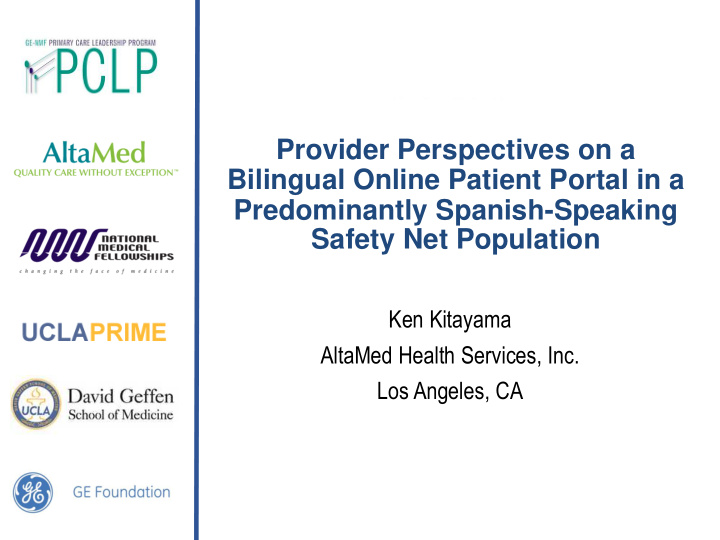



Provider Perspectives on a Bilingual Online Patient Portal in a Predominantly Spanish-Speaking Safety Net Population Ken Kitayama AltaMed Health Services, Inc. Los Angeles, CA
Introduction • The Centers for Medicare & Medicaid Services (CMS) mandate that eligible professionals (EPs) demonstrate that 5% of all patients enroll in a patient portal (PP) and send at least one secure message to their healthcare provider within the reporting period [1,2]. • Studies have demonstrated that provider endorsement significantly impacts PP adoption rates [3]. • Little is known about the barriers to the implementation of a bilingual English/Spanish PP in an under-resourced, predominantly Spanish- speaking patient population.
Methodology • In conjunction with the implementation of an online PP in June 2014, full-time primary care providers completed a 33-item multiple-choice survey and primary care patients completed a 37- item multiple-choice survey. • Surveys were administered during June and July 2014 at 12 of the 43 primary care clinics affiliated with AltaMed Health Services, a large, multi-site community health center with locations in LA & OC. • Patients were eligible if they were 18 years of age or older and were fluent in English or Spanish.
Results Provider Communication Behaviors and Preferences • Most providers (90%) indicated using the phone to communicate with their patients a few to many times/week, but the majority (63%) also play “phone tag” at that frequency. • Very few providers indicated using an asynchronous communication method like email (5%) or text messaging (2%) to communicate with their patients (Table 1). Provider PP Concerns, Benefits, and Endorsement • PP Concerns: the majority of providers (85%) were concerned about having to carve out time to reply to PP messages, and most providers were concerned about reimbursement issues (64%) and that patients would use the PP for an issue best addressed face-to-face (Table 2). • PP Benefits: about half of providers (51%) believed that the PP will reduce unnecessary clinic visits, and less than half of providers believe it will strengthen the patient-provider relationship (37%) or improve patient outcomes (46%). Nevertheless, most providers believed the PP will improve patient satisfaction (Table 2) • PP Endorsement: A little over half of providers (59%) somewhat or strongly support the PP, but less than half (39%) reported being likely or very likely to recommend the PP to their patients (Table 2). Patient vs. Provider Opinions on PP Benefits and Barriers • Patients were more likely to believe the PP will strengthen the patient-provider relationship (72% vs. 37%, p < 0.001), that it will help reduce unnecessary clinic visits (87% vs. 51%, p < 0.001), and that a mobile PP is useful (80% vs. 53%, p < 0.001) (Figure 1 and Table 3). • Patients were also more likely to believe that providers should take ≤ 2 days to respond to PP messages (93% vs. 58%, p < 0.001)
Results
Results Believes Mobile 80% 53% PP is Useful PP will help avoid 87% unnecessary visits 51% PP wil strengthen 72% patient-provider… 37% Concerned 53% about security… 54% ≤ 2 days to 93% … 58% respond to 0% 20% 40% 60% 80% 100% Patients (margin of Providers (margin error = 4.9%) n = 400 of error = 9%) n = 59
Recommendations • Inform providers of the many benefits associated with patient portal use (improved patient satisfaction, increased productivity, better clinical outcomes, etc.). • Reassure providers that patient portal use helps to increase clinic efficiency (less telephone tag, asynchronous communication, etc.). • Share patients’ generally positive perspectives regarding MyAltaMed with providers and encourage providers to promote patient portal adoption. • Allow for protected administrative time to allow providers to respond to patient messages.
Conclusion • Providers are hesitant to encourage patient PP use because of concerns about increased workload and reimbursement for time spent replying to PP messages, despite the fact they believe it will improve patient satisfaction. • At implementation, most providers were not familiar or comfortable with PP. Perhaps lack of endorsement is due to providers’ lack of familiarity or comfort level with PP. • There is a clear discrepancy between patient and provider opinions about PP barriers and benefits, with providers being more likely to believe that PP barriers outweigh the benefits. • An appropriate incentives program should be elaborated by the health system to increase provider endorsement of PP.
Acknowledgements • Michael Hochman, MD, MPH • Felix Carpio, MD, MPH • Michael Eaton, PA-C • Francis Kakuhikire, ITIL V3 • Charles Vega, MD • Michael Rodriguez, MD, MPH • Bessie Ramos • Sebastian Uijtdehaage, PhD • Michelle Vermillion
References [1] Roter DL, Larson S, Sands DZ, Ford DE, Houston T. Can e- mail messages between patients and physicians be patient- centered?. Health Commun. 2008;23(1):80-6. [2] Houston TK, Sands DZ, Jenckes MW, Ford DE. Experiences of patients who were early adopters of electronic communication with their physician: satisfaction, benefits, and concerns. Am J Manag Care. 2004;10(9):601-8. [3] Schickedanz A, Huang D, Lopez A, et al. Access, interest, and attitudes toward electronic communication for health care among patients in the medical safety net. J Gen Intern Med. 2013;28(7):914-20.
Recommend
More recommend